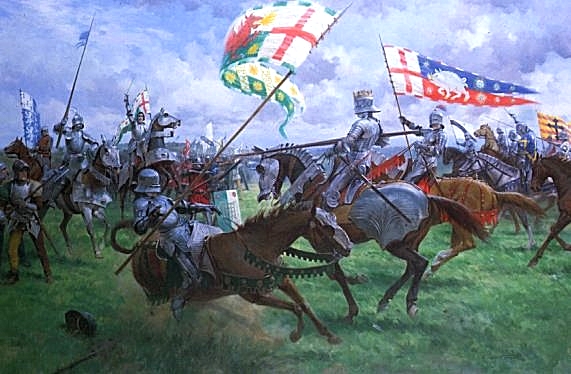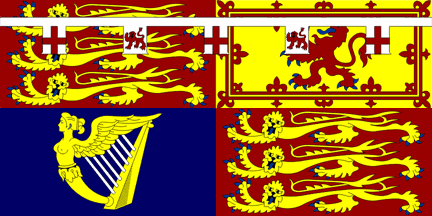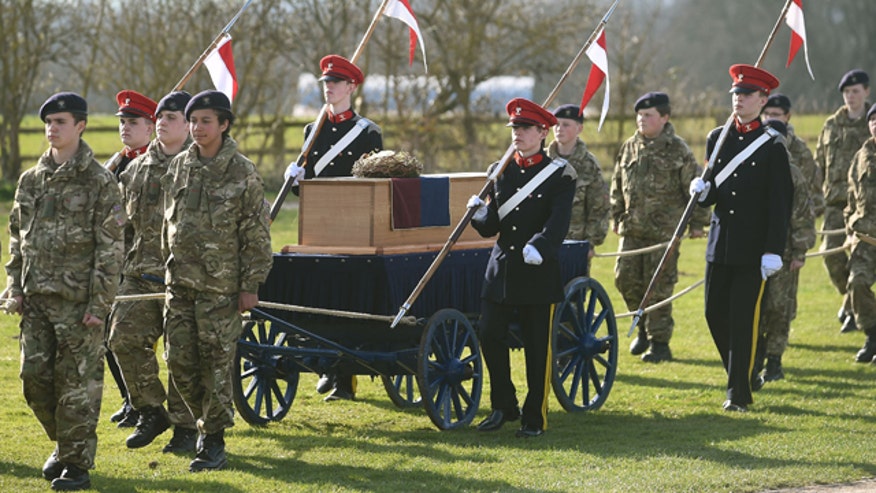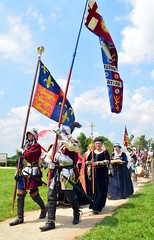His mortal remains were quickly buried at Greyfriars in Leicester, however this friary was destroyed by Henry VIII during the English Reformation, and the King's remains were lost. There was even a legeand (now disproven) that the remains thrown off a near by bridge into the River Soar. In August 2012 an archeology survey conducted by the University of Leicester, the Richard III Society and city council in a car park found the bones of a male, who suffered from Scoliosis and various severe head wounds, under a parking space that was oddly enough marked "R.". After scientific study and research including DNA testing, it was confirmed these were the bones of Richard III.
 |
| The parking space under which Richard III was buried, complete with a portrait and banner left by admirers possibly Richard III Society members |
"The Return of the King" was on Sunday when the remains were transported from the University of Leicester to Leicester Cathedral via Bosworth field where he was killed, with a short ceremony at each of the three places. This unusual procession is of interest to those interested in flags and heraldry.
On leaving the University a Royal British Legion Colour Part lowered their flags as the hearse passed.
The senior member of the Royal Family at Sunday's event was HRH Prince Richard, Duke of Gloucester (the same title Richard III held before becoming King) his standard would have been used to mark his presence at the university. His flag is the Royal standard with five white labels alternating between a red cross and red lion passant:
At Bosworth field Richard's Coffin was pulled by a Army Cadets who's sponsor unit was 9th/12 Royal Lancers and as such the coffin guards carried lances with traditional red and white lance pennants.
As seen the King's coffin was not draped in his banner, but it was decorated by his livery colours. At Bosworth Field a reproduction of Richard III's battle standard fluttered in the wind:
A standard's prime purpose in modern heraldry is to mark a headquarters(I guess main postal address might be the modern equivalent lol) meaning that unlike a banner the armiger doesn't need to be there in person for it to be used. In England Standards have the national flag at the hoist, and is usually divided into two livery colours. Richard's standard should be about 7.5 metres in length. The tail is split into two rounded ends and the flag normally depicts a crest and/or other heraldic badges.
King Richard's standard bears the white rose emblem of the Royal House of York to which he belonged, and a white boar which was his own personal badge, this along with his red and blue livery would have been worn by his followers.
A religious precision in period costume preceded the coffin, They carried various flags and flag related items. These included heralds and monks carrying vexilloids of Richards arms.
The monks also carried religious flags which bore the impersonations of saints and other religious figures including Edward I the Confessor the first patron saint of England.
These were all led by the Cross of St George the national banner of England's Patron saint defaced with a fleur de lee
After being drawn by horse through the streets of Leicester the Coffin arrived at the Cathedral, unfortunatly the coffin was no preceded by, or rapped in a royal banner. However this was done at the field:
However elongated versions of this flag, did decorate the street furniture outside the church.
The King's Cypher of RIII was also used on crimson flags with gold lettering by the council for the event. In the cathedral the coffin was draped with a specially made coffin drape, which among other things bore Richard III's coat of arms:
The shield of this variant of the Royal Arms of England will also be visible on the King's tomb inside the Cathedral as is his badge of the bore. Both White bore and white rose badges were worn by many of those in attendance.
The flag flown over the Cathedral was the standard Church of England design, of a Cross of St George with the diocese coat of arms in the canton, and can be seen in this news clip:
I have to say that as a person interested in Vexillology I was disappointed with the lack of flags (such as draping the coffin), but appart from that it was an interesting and dignified ceremony that was well done.










.svg/2000px-Coat_of_Arms_of_Richard_III_of_England_(1483-1485).svg.png)
I would like to know the reason his coffin wasn't draped with his coat of arms also.
ReplyDeleteI've searched the internet without success
mmmmm I wonder who said no !!